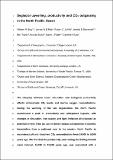Deglacial upwelling, productivity and CO2 outgassing in the North Pacific Ocean
Abstract
The interplay between ocean circulation and biological productivity affects atmospheric CO2 levels and marine oxygen concentrations. During the warming of the last deglaciation, the North Pacific experienced a peak in productivity and widespread hypoxia, with changes in circulation, iron supply and light limitation all proposed as potential drivers. Here we use the boron-isotope composition of planktic foraminifera from a sediment core in the western North Pacific to reconstruct pH and dissolved CO2 concentrations from 24,000 to 8,000 years ago. We find that the productivity peak during the Bølling–Allerød warm interval, 14,700 to 12,900 years ago, was associated with a decrease in near-surface pH and an increase in pCO2, and must therefore have been driven by increased supply of nutrient- and CO2-rich waters. In a climate model ensemble (PMIP3), the presence of large ice sheets over North America results in high rates of wind-driven upwelling within the subpolar North Pacific. We suggest that this process, combined with collapse of North Pacific Intermediate Water formation at the onset of the Bølling–Allerød, led to high rates of upwelling of water rich in nutrients and CO2, and supported the peak in productivity. The respiration of this organic matter, along with poor ventilation, probably caused the regional hypoxia. We suggest that CO2 outgassing from the North Pacific helped to maintain high atmospheric CO2 concentrations during the Bølling–Allerød and contributed to the deglacial CO2 rise.
Citation
Gray , W R , Rae , J W B , Wills , R C J , Shevenell , A E , Taylor , B , Burke , A , Foster , G L & Lear , C H 2018 , ' Deglacial upwelling, productivity and CO 2 outgassing in the North Pacific Ocean ' , Nature Geoscience , vol. 11 , no. 5 , pp. 340–344 . https://doi.org/10.1038/s41561-018-0108-6
Publication
Nature Geoscience
Status
Peer reviewed
ISSN
1752-0908Type
Journal article
Description
This work was funded by NERC studentship NE/I528185/1 awarded to W.R.G., NERC studentship NE/1492942/1 to B.T., NERC grant NE/N011716/1 awarded to J.W.B.R and A.B., and NERC grant NE/I013377/1 awarded to A.E.S.Collections
Items in the St Andrews Research Repository are protected by copyright, with all rights reserved, unless otherwise indicated.

